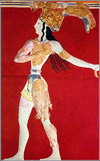Exam #1 Study guide Questions Flashcards
Osiris
god of the underworld and of vegetation; son of Geb and Nut; brother/husband of Osiris; brother of Set


Salisbury plain- South west England
Maat
goddess of truth and justice

Researchers believe that which Aegean mural may represent an initiation or fertility ritual?
Bull leaping fresco; strong virile male

Bull-Leaping Fresco
- Who made it: Minoans
- Where: Knossos palace in crete (Greece)
- When: 1400-1370 BCE
- Why: fertility/right of passage scene
- How: Fresco; painted on wet plaster
- Materials: Plaster
- Dimensions: 2’8” high
- Notes: Fresco paintings last longer and are easier to paint, this is why minoan art still has its color; the color is part of the wall
An overall assessment suggests that Aegean culture, unlike Egypt, was primarily concerned with ___________.
life; Ageans were more concerend with life than after life, their art shows it. Egyptians were more concerned with death and after life as shown in their works. Alot about a culture can be learned by critically looking at their art, since culture is the ultimate influence of artists.

Anatolia (Turkey)
Discuss the funerary objects found buried with Tutankhamun?
- intact jewlery, furnature, and sculpture
- Tutankhamun’s Mummy
- Tutankhmun’s Death mask
- Tutankhamun’s coffins
- Painted Chest with war scenes
- Canopic jars
- amulets
- book of dead- 200 spells
Tutankhamen’s mummy
- Found by Howard Carter in 1922
- Innermost of 3 coffins
- innermost coffin most luxurious
- made of beaten gold and semiprecious stones
- nemes headress and false beard
- found in Thebes
- ca.1323
- Gold inlay of enamel
- 6’1” long


Woman of Willendorf
- Who made it: Paleolithic artist
- Where: Willendorf, Austria
- When: 28,000-25,000 BCE
- Why: Fertility image?
- How: Carved
- Materials: limestone
- Dimensions: 4 1/4 inches tall
- Notes: Venus inappropriate name for it; not a deity, cluster of ball-like shapes on head, exaggerated female anatomy, small hands, no face
How were glazed bricks used in the architecture of Babylon?
Glazed bricks were used for the Ishtar gate in Babylon, Iraq. Glazed bricks were layed on top of non-glazed bricks, each glazed brick was molded separately and then set in proper sequence on the wall.

Register
- Organized info to tell story
- Mesopotamians and egyptians used them
- examples: Standard or Ur, Warka vase, Palette of Narmer

When, where and whom was the palace at Knossos constructed?
When: 2000-1375 BCE
Where: Knossos, Crete (Greek island)
Who: The Minoans, home of king Minos
Min
fertility god
Isis
mother goddess; daughter of Geb and Nut; sister/wife of Osiris

Minoan jewelers were especially skilled works in gold using several techniques. Explain these techniques.
- Repousse - a metal working technique in which Each mask was hammered from a single sheet of Gold and ornamented or shaped by hammering from the reverse side to create a design in low relief.
- Lost-Wax process - is the process by which a duplicate metal sculpture (often silver, gold, brass or bronze) is cast from an original sculpture. Dependent on the sculptor’s skills, intricate works can be achieved by this method.
- granulation/faience - grains adhered with alloy that melted just below melting point of gold to attach it (Suader it)
Anubis
god of the dead

What is the difference between corbel vaulting and post-and-lintel construction techniques?
Corbelled vault - a structure having the form of a vault but constructed on the principle of a corbel arch (A corbel arch is an arch-like construction method that uses the architectural technique of corbeling to span a space or void in a structure, such as an entranceway in a wall or as the span of a bridge)
Post-and-Lintel -a building system where strong horizontal elements are held up by strong vertical elements with large spaces between them.

Why might have prehistoric people built henges and how were they built?

Prehistoric people built henges over a period of years, using post-and lintel construction. Circles for monument were formed with human compass. Holes were dug into the ground and the stones were moved by multiple men using logs , stone was then pulled into place by men in vertical position. Dirt was piled around verticle stone to allow men to drag another stone up a vertical ramp and place it horazontally on posts. dirt was then cleared. Ditch was dug around henge with aubery pits between ditch and henge. It may have been built for astrological events, as temples or possibly funerary sites.

Amen (Amun)
“The Hidden One,” a primordial creation-deity. Up to the Middle Kingdom Amen was only the patron god of Thebes; later Amen became a prominent deity, and by Dynasty XVIII was termed the King of the Gods

Lost Wax technique
- Model is made of wax, clay, or wood
- make a cast of sculpture with plaster
- coat inside of cast with wax let harden
- Take wax out to reveal hollow wax version of sculpture
- put it in contaner attach wax at top for hole, the fill it up with plaster with sand
- let harden
- block of plater with wax in it; turn it over then heat it up
- let wax drain out until left with negative of sculpture inside
- pour molten metal into hole
- let cool; then break plaster open

Re (Ra; Re-Atum)
sun god; creator of Shu and Tefnut

Hathor
cow goddess. In some mythology she was the daughter of Nut and Re. In early mythology she was the mother of the sky god Horus, but was later replaced in this capacity by Isis. Hathor then became a protectress of Horus. She was depicted either as a cow or in human form wearing a crown consisting of a sun disk held between the horns of a cow.

Shu
god of the air (dry); partner of Tefnut and parent of Geb and Nut















































